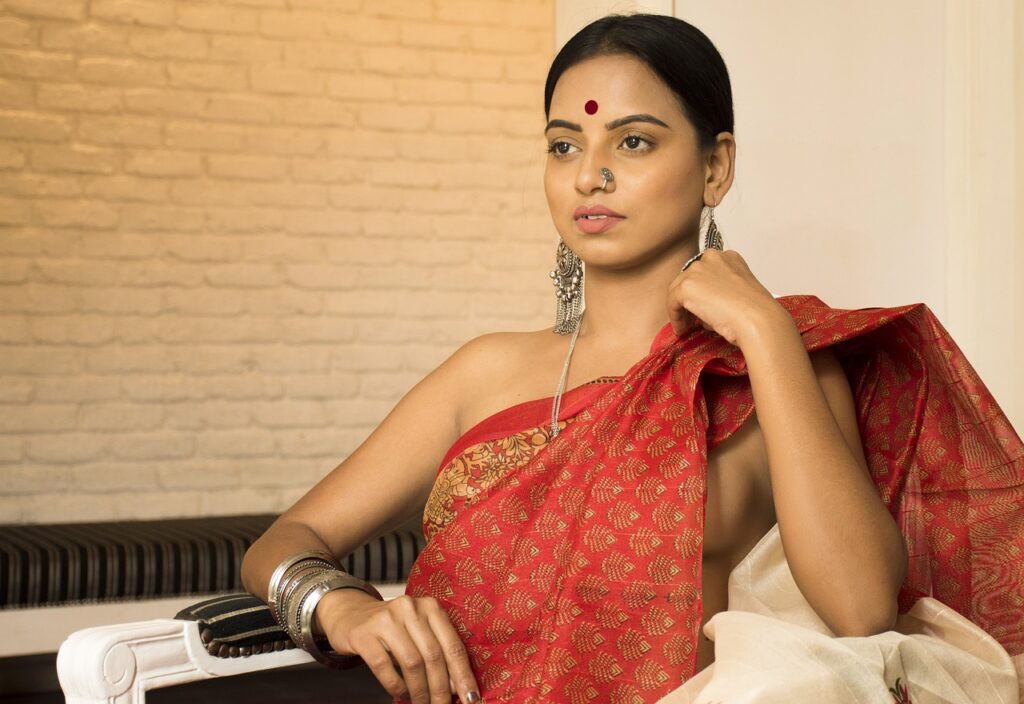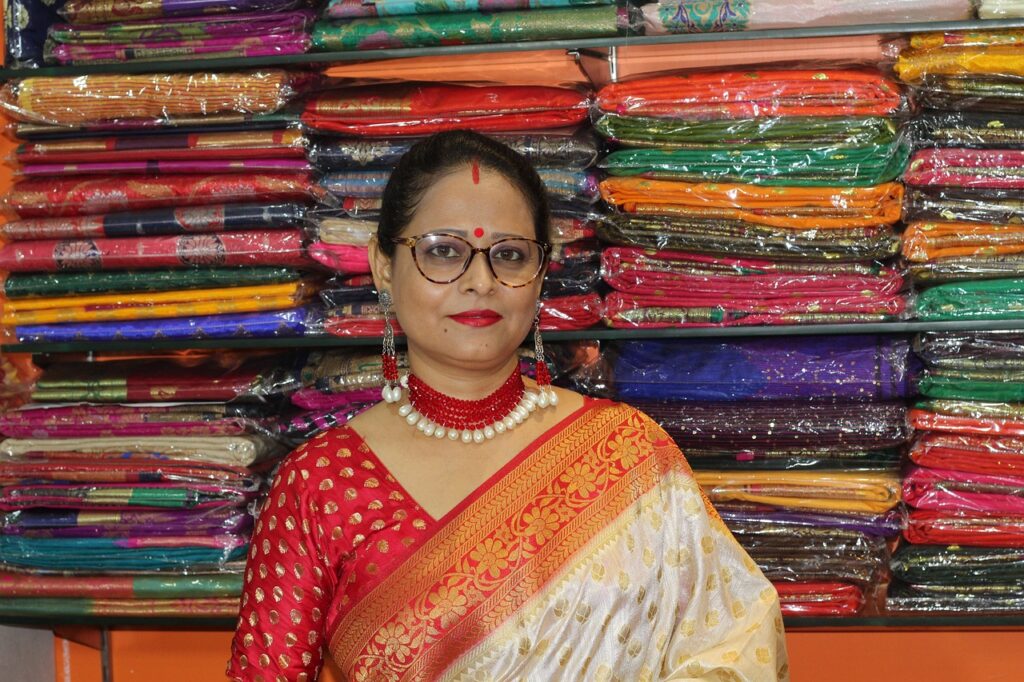Silk sarees are sets of clothing materials that have stood as a symbol of elegance and luxury for ages.
Mostly renowned for being worn amongst women of high class or in high positions in India, with their intricate designs, women find it amazing and captivating to be dressed in one of them.
There are various types of silk sarees, with their various colors and particular significance. There’s always something enchanting about this clothing material that simply draws attention.
With the likes of Banarasi sarees, which are decorated mostly with gold and diverse color beads, to Paithani Sarees, Chanderi Sarees, Baluchari Sarees, and Uppada Sarees.
Have you had the feel of any of these sarees? Or do you even know about them? If not, we wish to show you the various sarees that are rampant and frequently worn by women.
We wish to further draw your attention to the fact that most sarees have their names after the community where they originate from. Read along as we dive into the different types of silk sarees.
The Test of The Purity of Silk

Right from the stage of production, the silk is tested for purity or impurity. There are specific marks, certificates, or stamps that verify the purity of the silk. But most times, this verification comes from the brands and not the manufacturers.
Most times, a government-issued hologram is placed as a mark on the product. Try to check for any of these forms of identification on either the saree’s packaging or an official label.
9 Types of Silk Sarees
These are only a few of the magnificent types of silk sarees flaunted around, although there are various examples of sarees.
But for the sake of this article, we will talk mostly about the types of silk sarees that are frequently worn during important occasions and customary rites.
Each variety of these sarees is greatly sought after anyway, due to their individual appeal and cultural significance.
1. Banarasi Sarees
Mostly in India, this saree is among the most luxurious and esteemed traditional sarees. Originating from Varanasi (formerly Banaras) in Uttar Pradesh, these sarees are celebrated for their brilliant opulence, intricate design, and cultural significance.
A driving accessory that distinguishes Banaras sarees is the heavy zari (gold or silver thread) embroidery always attached to them.
They are made of fine and smooth silks of high quality. Luxury accompanies these sarees, as does a feel of rich texture. But nothing is more striking than the elaborate use of zari and metallic threads, which are often in gold or silver.
At times, the Banaras sarees get their inspiration from Mughal art and architecture and these crafted themes range from geometric shapes to floral patterns.
The Banaras saree has a deep cultural significance in Asia, mostly India, and this significance and roots are generationally passed. Globally now, it is recognizable to see a Banaras saree and identify the expertise of craftsmen.
2. Paithani Sarees
This type of silk saree has its origins in Paithan, Maharashtra, India. They are famous for their peacock designs, vibrant colors, and use of not only silk when attending occasions but both silk and zari to create unique patterns.
The quality of silk used in Paithani sarees is of the highest standard, contributing to the sarees’ luxurious form.
The elaborate and detailed collection and designs of Paithani sarees are what distinguish them. The expertly handwoven traditional Paithani features frequently include peacocks, parrots, florals, and geometrical designs. The outfit highlights the craftsmanship of the weavers and the various cultural influences on these sarees.
Also, there is a kaleidoscope that features hues, gold, and some other attractive color blends, all to present a more visual representation of beauty. Additionally, this types of silk saree has the feature of a loose end of the silk saree material; it’s called the pallu.
Particularly in Maharashtra, Paithani sarees possess immense cultural and traditional significance. They play a significant role in Maharashtrian weddings and other important events, representing grace and history. Paithani sarees have a Nauvari and a regular traditional style; hence, they are a valuable outfit for Indians, especially.
3. Chanderi Sarees
The Chanderi sarees originate from Chanderi in Madhya Pradesh, a town surrounded by hills southwest of the Betwa River, lakes, and forests. These sarees are lightweight and are known for their smoothness and fine texture.
Furthermore, the delicate checkered design known as “chanderi booti” is a characteristic of Chanderi sarees. A delicate combination of pastel hues is frequently seen in Chanderi sarees.
These sarees have geometric patterns, peacocks, lotuses, and delicate hues like pastel pinks, blues, and greens. developing a dignified, elegant, and aesthetically pleasing color scheme.
Their comfort and elegance are enhanced by the silk and cotton blend used in their creation. Chanderi sarees are appreciated by women seeking elegant and comfortable clothing that is appropriate for both everyday use and formal occasions because of their simplicity and subdued beauty.
4. Mysore Silk Sarees
These sarees originate in Mysore, arnataka, and are made from pure silk. Mysore silk sarees reflect the cultural heritage of Karnataka and are cherished for their simplicity, comfort, and timeless beauty.
They are more than just garments. They are an expression of tradition and wealth and an embodiment of craftsmanship.
Subsequently, they frequently have rich hues, making them look basic yet lovely. The sarees’ opulent texture is a result of the use of silk from mulberry silkworms.
Mysore silk sarees are both simple and refined because of the subtle zari or gold and silver threadwork, that is frequently used in the borders or pallu.
The Mysore silk sarees are simple to wear because of their light fabric. Both official and casual settings are ideal for them.
As a result, it is a well-liked traditional option for women who like to dress traditionally. Additionally, it can be worn to festivals, weddings, and business gatherings. They skillfully combine traditional and modern aesthetics.
5. Baluchari Sarees
Baluchari sarees are an exquisite traditional types of silk sarees from the state of West Bengal, India, known for their unique and intricate pattern of design. These sarees have a very deep historical significance and a distinctive appeal of rich, contrasting colors.
Hence, they are renowned for weaving detailed Tussar silk and are regarded as a traditional treasure.
Their distinctive patterns, many of which feature scenes from the Ramayana and Mahabharata, two important Indian mythologies, can be used to identify them.
They are not just clothes; they are intricate works of art created by labor-intensive handweaving methods.
Skilled weavers create the majority of baluchari sarees, and they frequently use home-based handloom machines to create these exquisite garments.
The process involves painstakingly weaving highly prized patterns and designs from Indian mythology using the extra-weft technique.

6. Patola Sarees
Patola sarees come from Patan, Gujarat. They are famous for their double ikat technique, which involves dyeing both the warp and weft threads before weaving to create detailed geometric patterns.
These exquisite sarees are celebrated for their rich history, vibrant colors, and traditional motifs.
Fine silk is used to make patola sarees, giving them a lustrous and opulent texture. The silk that is used is usually of the highest caliber and is renowned for its plush texture and inherent sheen.
They feature shapes like squares, circles, and diamonds in a geometric pattern. As a result, the weaving process calls for extraordinary finesse and attention to detail.
Reversibility is another one of Patola sarees’ distinctive qualities. The meticulously woven patterns are identical on both sides, showcasing the craftsmen’s exceptional weaving skills. Generations have passed down the craft of patola weaving to one another.
7. Gadwal Sarees
Gadwal sarees, which come from the town of Gadwal in the Indian state of Telangana, are renowned for their distinctive weave and fashion sense. These exquisite cotton and silk sarees are prized for their grandness and contrasting borders.
The Gadwal saree is more than just a piece of clothing; it represents tradition and class, showcasing Telangana’s rich cultural heritage.
The intricate zari (gold or silver thread) work on the borders, which can be wide and ornate, adds to the saree’s opulence. Gadwal sarees need to be created to preserve Telangana’s rich textile heritage.
8. Kota Doria Sarees
Kota Doria Sarees, hailing from the city of Kota in Rajasthan, are a testament to the skillful artistry and textile tradition of the region. These sarees are celebrated for their delicate texture, fine cotton and silk blend, and charming checkered patterns.
In addition to being aesthetically pleasing, the lattice patterns on Kota Doria sarees also have practical uses. They make the sarees breathable, making them appropriate for hot, muggy climates and perfect for daily wear.
The elegant, cozy, and timelessly beautiful Kota Doria sarees capture the rich textile heritage of Rajasthan. They are more than just clothes; they are adorning women with the elegance and charm of Rajasthan’s cultural legacy.
9. Muga Silk Sarees
Due to their exquisite Muga silk, deep golden sheen, and unique patterns, these sarees are highly sought-after. Muga silk is known for its exquisite texture, exceptional durability, and natural golden sheen.
Traditional Assamese motifs such as flora and fauna, such as lotus, peacocks, elephants, and more, are frequently found on Muga silk sarees. They can be worn for formal and informal attire and are not just for special occasions.
Manufacturing Process Of Silk Sarees
One of the earliest types of fiber still in use is silk, which silkworms create by spinning around their cocoons. Starting with the eggs, the process continues until the worms are fully grown and begin to form cocoons.
For the caterpillars to lay eggs and produce larger cocoons, the silk farmers allowed the caterpillars to transform into moths.
Final Words
Purchasing a pure silk saree is an investment in craftsmanship and tradition, as well as a fashion statement. You can confidently determine the purity of a silk saree by taking into account elements like texture, sheen, weave, and authenticity marks. If you’re on the lookout for high-quality silk sarees, one brand that stands out is Adi Mohini Mohan Kanjilal.



